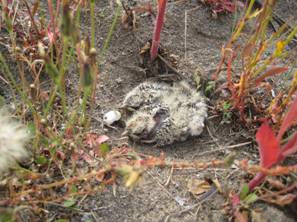This is a subspecies of horned lark found in western Washington and Oregon that was recently listed as Threatened by the U.S. Fish and Wildlife Service. Their range is broken into three areas: the Washington Puget lowlands, the WA coast and lower Columbia River islands (including dredge spoils), and the Oregon Willamette Valley. The current population is estimated to be between 1,170 – 1,610 individuals.
The original scientific name, Alauda alpestris meant “lark of the mountains, but it has been moved to the genus Eremophila- from the Greek Eremos for “lonely” and philoe for love – I’m not sure how “lonely lover” is connected to this bird (?). The subspecies strigata, means striped.
The “horns” on the male in the above picture are pretty obvious – the faint “streaks” on his breast less so. Adult birds eat a variety of seeds and some insects but, as is typical for many seed-eaters, the young birds are fed only insects because they need more protein for their early growth spurt. Eggs are laid beginning typically in early May and may extend through mid-August. Nests are very simple, either a natural depression on the ground or one scraped out by the female. If you are a ground-nesting bird you had better be pretty good at camouflage as your first defense. Any number of animals will prey on young larks including kestrels, western meadowlarks, killdeer, harriers, raccoons, opossums, and domestic cats.

These birds prefer low grass with sparse ground cover – typically in grass less than two feet tall. Landcover used includes native prairie, grazed pastures, mudflats, gravel roads, dredge spoils, and plowed fields. Here’s a short video of an adult feeding the youngsters: https://www.youtube.com/watch?v=uTBiYWdstGU You might be more familiar with the common horned lark east of the Cascades that is found along sparse sagebrush ridges.
The streaked horned lark is a distinct subspecies – genetic testing indicates that the streaked horned larks in western Oregon and Washington are isolated and much different from their more interior relative. But wait a minute you say – I thought it was the Endangered Species Act, not the Subspecies Act. True enough, but the federal regulation allows for protection of Distinct Population Segments to retain long-term genetic diversity. A similar situation persists where marbled murrelets (a small seabird) are listed as Threatened in WA, OR, and CA, but are pretty common in SE Alaska. Biologists in our Portland and Seattle offices have been surveying for streaked horned larks at several airports including Salem and McMinnville OR and Olympia, WA.
Airports need to make to make their lands less “bird-friendly”, which involves removing trees and shrubs, to reduce the hazard of airplane collisions with birds. So the remaining short grass habitat turns out to be just great for streaked horned larks! In 2012 an Air Force F-15 at the Portland Air Show collided with a bird that later through “mtDNA ND2 gene sequence for identification from feather and tissue remains” (translation: DNA analysis of squished bird parts) identified the bird as a streaked horned lark! Given the rarity of the birds – what are the chances, eh?
Often we hear these birds before we see them. Their song is a high-pitched squeaky-tinkle (technical term) that can be difficult to figure out the direction of the source. The males will help out by conducting an aerial territorial display. They will fly in an ascending circle while singing, rising to 200 ft or more and will fan out their tail feathers. For a few minutes they will circle about like this and then suddenly dive straight to the ground and land – quite impressive really. Fighting males will peck and claw at each other while flying straight up. An average territory for a pair is thought to be about 2 acres.
An interesting twist of habitat selection is that because the birds prefer sites with sparse vegetation they have been nesting on dredge spoil sites along the Columbia River and some areas with recently cleared land – unintentionally providing a nesting sites.
I just got back this morning from another lark survey at the Olympia Airport (meeting with my field partner at 4:00 a.m. – yawn). This municipal airport once had shrubs and a remnant Christmas tree farm on it but all the woody vegetation was cleared to reduce the available bird habitat. But this transformed it into great low grass habitat for larks. In south Puget Sound this subspecies used to nest in native outwash gravel prairies that are very well drained and supported only herbs and grasses. But many of these sites have been developed, reducing an already limited habitat base. It is the tail end of the nesting season and the birds are more widely dispersed – so no luck seeing any of them today, which is ok given that the airport is in the midst of repairing some runways and taxiways. Our earlier surveys clarified lark use patterns at the site and helped plan which phase should start first to minimize disturbances to nesting pairs.
So if you’re interested in seeing these birds check with one of the biologists in the office and they can suggest some places for next spring – and then set your alarm for 0-dark-thirty. Early birder gets the lark, or something like that.
